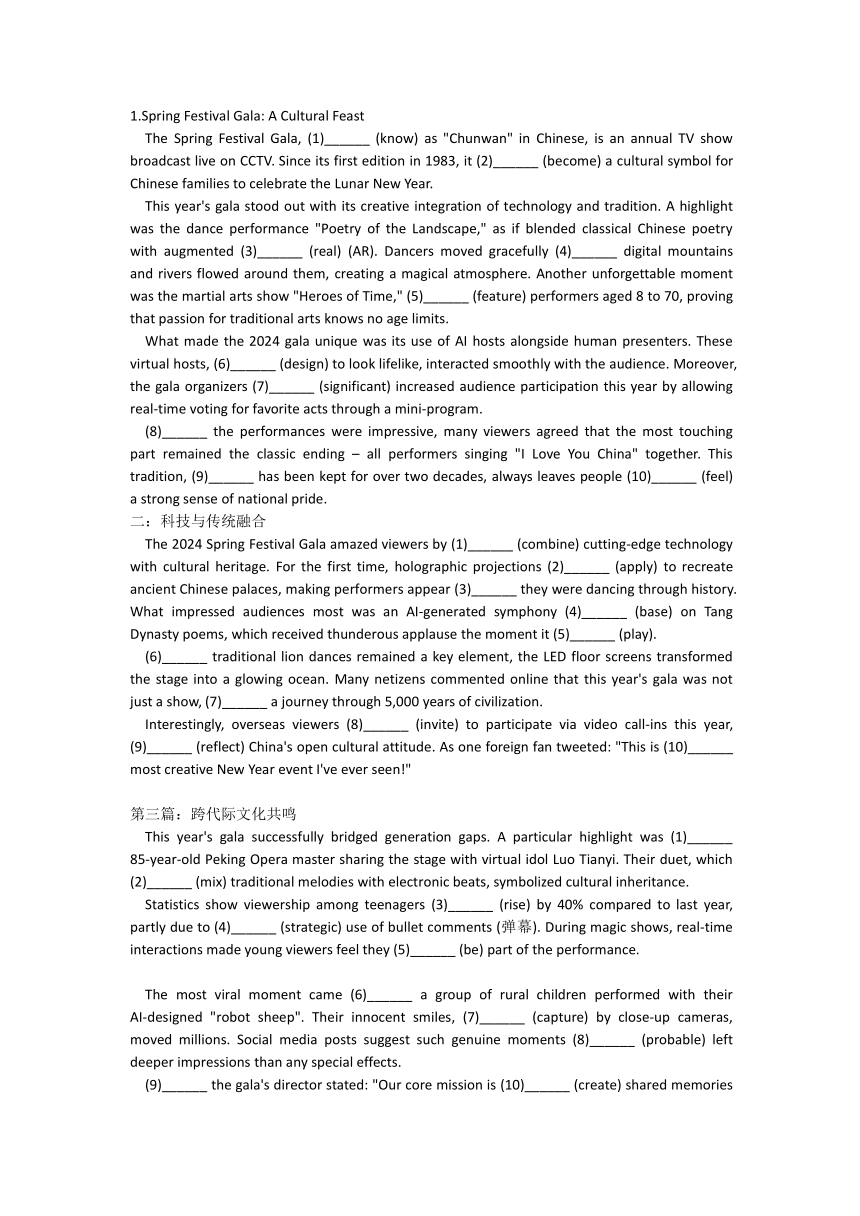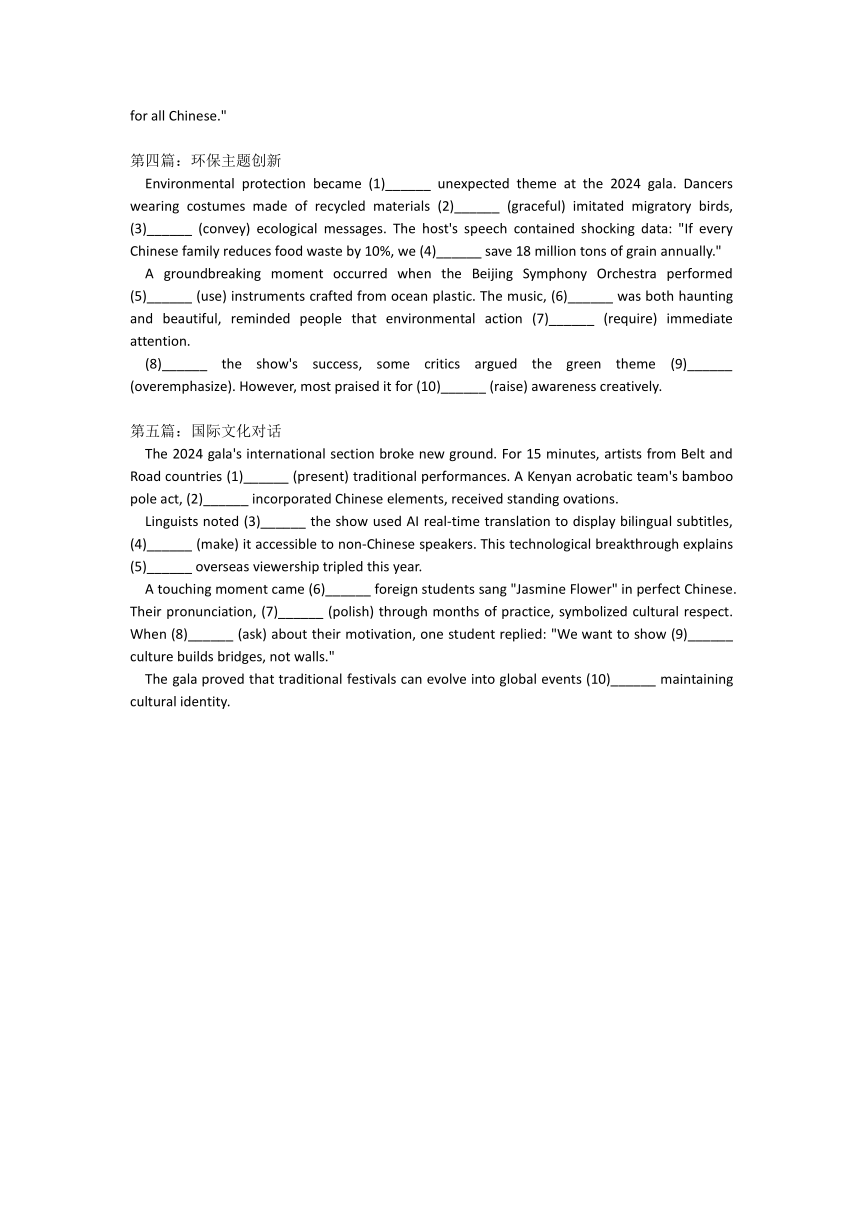2025年春晚主题语法填空练习五篇(含解析)-2025届高三英语复习专项
文档属性
| 名称 | 2025年春晚主题语法填空练习五篇(含解析)-2025届高三英语复习专项 |  | |
| 格式 | docx | ||
| 文件大小 | 20.6KB | ||
| 资源类型 | 教案 | ||
| 版本资源 | 人教版(2019) | ||
| 科目 | 英语 | ||
| 更新时间 | 2025-02-01 22:55:08 | ||
图片预览


文档简介
1.Spring Festival Gala: A Cultural Feast
The Spring Festival Gala, (1)______ (know) as "Chunwan" in Chinese, is an annual TV show broadcast live on CCTV. Since its first edition in 1983, it (2)______ (become) a cultural symbol for Chinese families to celebrate the Lunar New Year.
This year's gala stood out with its creative integration of technology and tradition. A highlight was the dance performance "Poetry of the Landscape," as if blended classical Chinese poetry with augmented (3)______ (real) (AR). Dancers moved gracefully (4)______ digital mountains and rivers flowed around them, creating a magical atmosphere. Another unforgettable moment was the martial arts show "Heroes of Time," (5)______ (feature) performers aged 8 to 70, proving that passion for traditional arts knows no age limits.
What made the 2024 gala unique was its use of AI hosts alongside human presenters. These virtual hosts, (6)______ (design) to look lifelike, interacted smoothly with the audience. Moreover, the gala organizers (7)______ (significant) increased audience participation this year by allowing real-time voting for favorite acts through a mini-program.
(8)______ the performances were impressive, many viewers agreed that the most touching part remained the classic ending – all performers singing "I Love You China" together. This tradition, (9)______ has been kept for over two decades, always leaves people (10)______ (feel) a strong sense of national pride.
二:科技与传统融合
The 2024 Spring Festival Gala amazed viewers by (1)______ (combine) cutting-edge technology with cultural heritage. For the first time, holographic projections (2)______ (apply) to recreate ancient Chinese palaces, making performers appear (3)______ they were dancing through history. What impressed audiences most was an AI-generated symphony (4)______ (base) on Tang Dynasty poems, which received thunderous applause the moment it (5)______ (play).
(6)______ traditional lion dances remained a key element, the LED floor screens transformed the stage into a glowing ocean. Many netizens commented online that this year's gala was not just a show, (7)______ a journey through 5,000 years of civilization.
Interestingly, overseas viewers (8)______ (invite) to participate via video call-ins this year, (9)______ (reflect) China's open cultural attitude. As one foreign fan tweeted: "This is (10)______ most creative New Year event I've ever seen!"
第三篇:跨代际文化共鸣
This year's gala successfully bridged generation gaps. A particular highlight was (1)______ 85-year-old Peking Opera master sharing the stage with virtual idol Luo Tianyi. Their duet, which (2)______ (mix) traditional melodies with electronic beats, symbolized cultural inheritance.
Statistics show viewership among teenagers (3)______ (rise) by 40% compared to last year, partly due to (4)______ (strategic) use of bullet comments (弹幕). During magic shows, real-time interactions made young viewers feel they (5)______ (be) part of the performance.
The most viral moment came (6)______ a group of rural children performed with their AI-designed "robot sheep". Their innocent smiles, (7)______ (capture) by close-up cameras, moved millions. Social media posts suggest such genuine moments (8)______ (probable) left deeper impressions than any special effects.
(9)______ the gala's director stated: "Our core mission is (10)______ (create) shared memories for all Chinese."
第四篇:环保主题创新
Environmental protection became (1)______ unexpected theme at the 2024 gala. Dancers wearing costumes made of recycled materials (2)______ (graceful) imitated migratory birds, (3)______ (convey) ecological messages. The host's speech contained shocking data: "If every Chinese family reduces food waste by 10%, we (4)______ save 18 million tons of grain annually."
A groundbreaking moment occurred when the Beijing Symphony Orchestra performed (5)______ (use) instruments crafted from ocean plastic. The music, (6)______ was both haunting and beautiful, reminded people that environmental action (7)______ (require) immediate attention.
(8)______ the show's success, some critics argued the green theme (9)______ (overemphasize). However, most praised it for (10)______ (raise) awareness creatively.
第五篇:国际文化对话
The 2024 gala's international section broke new ground. For 15 minutes, artists from Belt and Road countries (1)______ (present) traditional performances. A Kenyan acrobatic team's bamboo pole act, (2)______ incorporated Chinese elements, received standing ovations.
Linguists noted (3)______ the show used AI real-time translation to display bilingual subtitles, (4)______ (make) it accessible to non-Chinese speakers. This technological breakthrough explains (5)______ overseas viewership tripled this year.
A touching moment came (6)______ foreign students sang "Jasmine Flower" in perfect Chinese. Their pronunciation, (7)______ (polish) through months of practice, symbolized cultural respect. When (8)______ (ask) about their motivation, one student replied: "We want to show (9)______ culture builds bridges, not walls."
The gala proved that traditional festivals can evolve into global events (10)______ maintaining cultural identity.
答案与解析:
一:
1. known (非谓语动词,过去分词作后置定语)
2. has become (动词时态,现在完成时表持续)
3. which (定语从句关系代词)
4. as/while (连词,时间/伴随状语)
5. featuring (非谓语动词,现在分词作伴随状语)
6. designed (非谓语动词,过去分词表被动)
7. significantly (副词修饰动词)
8. Although/While (让步状语从句连词)
9. that/which (定语从句关系代词)
10. feeling (非谓语动词,现在分词作宾语补足语)
二:
答案与解析:
1. combining (动名词作宾语)
2. were applied (被动语态时态)
3. reality (形容词后用名词)
4. based (过去分词作定语)
5. was played (时态与语态)
6. Although/While (让步状语连词)
7. but (not...but结构)
8. were invited (被动语态)
9. reflecting (现在分词作结果状语)
10. the (最高级冠词)
三:
答案与解析:
1. an (不定冠词)
2. mixed (时态)
3. has risen (现在完成时)
4. strategic (形容词作定语)
5. were (虚拟语气)
6. when (时间状语连词)
7. captured (过去分词作定语)
8. probably (副词修饰动词)
9. As (连词引导定语从句)
10. to create (不定式作表语)
四:
答案与解析:
1. an (冠词)
2. gracefully (副词修饰动词)
3. conveying (现在分词作伴随状语)
4. could (情态动词表可能性)
5. using (现在分词作方式状语)
6. which (非限定性定语从句)
7. requires (主谓一致)
8. Despite (介词表让步)
9. was overemphasized (被动语态)
10. raising (动名词作宾语)
五:
1. presented (时态)
2. which (非限定性定语从句)
3. that (宾语从句连词)
4. making (现在分词作结果状语)
5. why (宾语从句连词)
6. when (时间状语连词)
7. polished (过去分词作定语)
8. asked (省略句being asked)
9. how (宾语从句连词)
10. while (连词表对比)
The Spring Festival Gala, (1)______ (know) as "Chunwan" in Chinese, is an annual TV show broadcast live on CCTV. Since its first edition in 1983, it (2)______ (become) a cultural symbol for Chinese families to celebrate the Lunar New Year.
This year's gala stood out with its creative integration of technology and tradition. A highlight was the dance performance "Poetry of the Landscape," as if blended classical Chinese poetry with augmented (3)______ (real) (AR). Dancers moved gracefully (4)______ digital mountains and rivers flowed around them, creating a magical atmosphere. Another unforgettable moment was the martial arts show "Heroes of Time," (5)______ (feature) performers aged 8 to 70, proving that passion for traditional arts knows no age limits.
What made the 2024 gala unique was its use of AI hosts alongside human presenters. These virtual hosts, (6)______ (design) to look lifelike, interacted smoothly with the audience. Moreover, the gala organizers (7)______ (significant) increased audience participation this year by allowing real-time voting for favorite acts through a mini-program.
(8)______ the performances were impressive, many viewers agreed that the most touching part remained the classic ending – all performers singing "I Love You China" together. This tradition, (9)______ has been kept for over two decades, always leaves people (10)______ (feel) a strong sense of national pride.
二:科技与传统融合
The 2024 Spring Festival Gala amazed viewers by (1)______ (combine) cutting-edge technology with cultural heritage. For the first time, holographic projections (2)______ (apply) to recreate ancient Chinese palaces, making performers appear (3)______ they were dancing through history. What impressed audiences most was an AI-generated symphony (4)______ (base) on Tang Dynasty poems, which received thunderous applause the moment it (5)______ (play).
(6)______ traditional lion dances remained a key element, the LED floor screens transformed the stage into a glowing ocean. Many netizens commented online that this year's gala was not just a show, (7)______ a journey through 5,000 years of civilization.
Interestingly, overseas viewers (8)______ (invite) to participate via video call-ins this year, (9)______ (reflect) China's open cultural attitude. As one foreign fan tweeted: "This is (10)______ most creative New Year event I've ever seen!"
第三篇:跨代际文化共鸣
This year's gala successfully bridged generation gaps. A particular highlight was (1)______ 85-year-old Peking Opera master sharing the stage with virtual idol Luo Tianyi. Their duet, which (2)______ (mix) traditional melodies with electronic beats, symbolized cultural inheritance.
Statistics show viewership among teenagers (3)______ (rise) by 40% compared to last year, partly due to (4)______ (strategic) use of bullet comments (弹幕). During magic shows, real-time interactions made young viewers feel they (5)______ (be) part of the performance.
The most viral moment came (6)______ a group of rural children performed with their AI-designed "robot sheep". Their innocent smiles, (7)______ (capture) by close-up cameras, moved millions. Social media posts suggest such genuine moments (8)______ (probable) left deeper impressions than any special effects.
(9)______ the gala's director stated: "Our core mission is (10)______ (create) shared memories for all Chinese."
第四篇:环保主题创新
Environmental protection became (1)______ unexpected theme at the 2024 gala. Dancers wearing costumes made of recycled materials (2)______ (graceful) imitated migratory birds, (3)______ (convey) ecological messages. The host's speech contained shocking data: "If every Chinese family reduces food waste by 10%, we (4)______ save 18 million tons of grain annually."
A groundbreaking moment occurred when the Beijing Symphony Orchestra performed (5)______ (use) instruments crafted from ocean plastic. The music, (6)______ was both haunting and beautiful, reminded people that environmental action (7)______ (require) immediate attention.
(8)______ the show's success, some critics argued the green theme (9)______ (overemphasize). However, most praised it for (10)______ (raise) awareness creatively.
第五篇:国际文化对话
The 2024 gala's international section broke new ground. For 15 minutes, artists from Belt and Road countries (1)______ (present) traditional performances. A Kenyan acrobatic team's bamboo pole act, (2)______ incorporated Chinese elements, received standing ovations.
Linguists noted (3)______ the show used AI real-time translation to display bilingual subtitles, (4)______ (make) it accessible to non-Chinese speakers. This technological breakthrough explains (5)______ overseas viewership tripled this year.
A touching moment came (6)______ foreign students sang "Jasmine Flower" in perfect Chinese. Their pronunciation, (7)______ (polish) through months of practice, symbolized cultural respect. When (8)______ (ask) about their motivation, one student replied: "We want to show (9)______ culture builds bridges, not walls."
The gala proved that traditional festivals can evolve into global events (10)______ maintaining cultural identity.
答案与解析:
一:
1. known (非谓语动词,过去分词作后置定语)
2. has become (动词时态,现在完成时表持续)
3. which (定语从句关系代词)
4. as/while (连词,时间/伴随状语)
5. featuring (非谓语动词,现在分词作伴随状语)
6. designed (非谓语动词,过去分词表被动)
7. significantly (副词修饰动词)
8. Although/While (让步状语从句连词)
9. that/which (定语从句关系代词)
10. feeling (非谓语动词,现在分词作宾语补足语)
二:
答案与解析:
1. combining (动名词作宾语)
2. were applied (被动语态时态)
3. reality (形容词后用名词)
4. based (过去分词作定语)
5. was played (时态与语态)
6. Although/While (让步状语连词)
7. but (not...but结构)
8. were invited (被动语态)
9. reflecting (现在分词作结果状语)
10. the (最高级冠词)
三:
答案与解析:
1. an (不定冠词)
2. mixed (时态)
3. has risen (现在完成时)
4. strategic (形容词作定语)
5. were (虚拟语气)
6. when (时间状语连词)
7. captured (过去分词作定语)
8. probably (副词修饰动词)
9. As (连词引导定语从句)
10. to create (不定式作表语)
四:
答案与解析:
1. an (冠词)
2. gracefully (副词修饰动词)
3. conveying (现在分词作伴随状语)
4. could (情态动词表可能性)
5. using (现在分词作方式状语)
6. which (非限定性定语从句)
7. requires (主谓一致)
8. Despite (介词表让步)
9. was overemphasized (被动语态)
10. raising (动名词作宾语)
五:
1. presented (时态)
2. which (非限定性定语从句)
3. that (宾语从句连词)
4. making (现在分词作结果状语)
5. why (宾语从句连词)
6. when (时间状语连词)
7. polished (过去分词作定语)
8. asked (省略句being asked)
9. how (宾语从句连词)
10. while (连词表对比)
